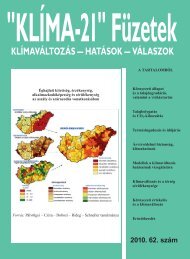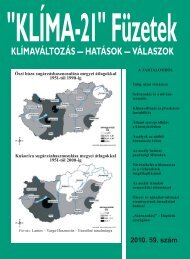KLÃMA-21 Füzetek 61. szám - VAHAVA Hálózat
KLÃMA-21 Füzetek 61. szám - VAHAVA Hálózat
KLÃMA-21 Füzetek 61. szám - VAHAVA Hálózat
Create successful ePaper yourself
Turn your PDF publications into a flip-book with our unique Google optimized e-Paper software.
196 „KLÍMA-<strong>21</strong>” FÜZETEK: KLÍMAVÁLTOZÁS – HATÁSOK – VÁLASZOK<br />
A GENERAL DISASTER MANAGEMENT SYSTEM MODEL CONCEPT<br />
By<br />
BUKOVICS, ISTVÁN<br />
Keywords: disaster management, system model, concept, strategy, tasks.<br />
In consideration of the reserves and challenges identified by science, new strategic goals<br />
may be set:<br />
– Improving civilian satisfaction, strengthening citizen orientation.<br />
– Delivering safety with a focus on quality.<br />
– Quality sustainable development, sustainable safety.<br />
– Integrated law enforcement capabilities, application of state-of-the-art control and planning<br />
models.<br />
– Improving partnership with formal and informal communities.<br />
– A shift towards problem-solving service.<br />
– Using best practice.<br />
– Intelligent, innovative safety.<br />
Pending and new priority tasks may make up the „climate strategy” of the strategic management<br />
for disaster management, consisting of several concurrent complementary activities<br />
– both smaller projects and larger programmes – building upon one another. The tools of<br />
strategic management are most useful in the ongoing planning, control and evaluation of such<br />
projects and programmes, as well as in communicating their results and transferring such<br />
results into practice.<br />
– A database (electronic documentation) containing the disaster management events and<br />
measures relevant to climate change is warranted.<br />
– Data pertaining to major climate change trends and meteorological information on a<br />
global and national level and on the level of the Carpathian Basin should be continuously<br />
obtained from scientific sources.<br />
– The information compiled into databases should be stored, organised and made presentable<br />
using geospatial and other analysis software.<br />
– Disaster management challenges induced by climate change (both already active ones<br />
and potential threats) should be enumerated and clarified.<br />
– The adoption of a novel risk analysis method in protecting the population is especially<br />
desirable.<br />
– Formulating the legislative changes made necessary by the effects of climate change<br />
from time to time.<br />
– Laying down the climate change related requirements for the concepts determining the<br />
development of control and management system and HR operations (other than education and<br />
further training).<br />
– Technical development and investment (e.g. specialised automobiles, fire extinguishing<br />
and technical rescue equipment, special tools for exploring damage areas, monitor systems<br />
and/or its components, mobile air conditioners, pumps and air exchanging equipment of various<br />
capacity, tents and containers with heat insulation, watercraft etc.), procuring new equip-






